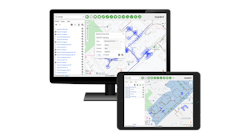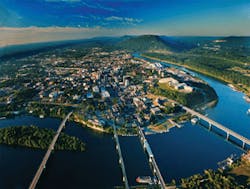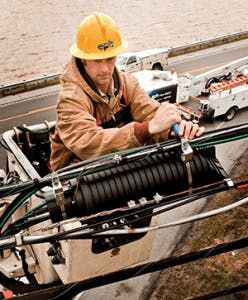Electric Power Board Enrolls the Help of a Little Light
Chattanooga, Tennessee, has long been known as a city of pioneers, both in history and in technology. With a rich legacy of entrepreneurs, the once small town has quickly grown to become one of the most innovative cities in America today. With help from the city-owned electricity distribution and telecommunications company Electric Power Board (EPB), Chattanooga has evolved from a mid-sized industrial town into one of the most advanced communication cities in the world. Known as America’s first "Gig City", Chattanooga, has now staked its claim on becoming the world’s first 10 G community-wide city, and both business and residential customers are flocking to the "Gig" as needs for greater data capacity and speeds continue to increase in today’s digital economy.
But it wasn’t always this way. Part of a much larger transformation effort, Chattanooga’s path toward becoming a multi-Gig city was different than most, driven largely by the need to upgrade its power grid.
A view from above — the city of Chattanooga, or the "Gig city", where EPB is deploying multi-gigabit ultra-broadband access.
"EPB’s goal has always been to provide the residents of Chattanooga with ubiquitous access to reliable and affordable electricity," said Danna Bailey, Vice President of Corporate Communications. "Modernizing our electric grid was a critical step to ensuring we could continue to deliver on this promise. The challenge came in finding a solution that would not only benefit the utility but also provide ever-growing value to the community we served. We wanted to make sure that any investment in the network would also provide future benefits to our customers that went way beyond simply automating meter readings."
Evaluating the Options
In the early 2000’s, EPB started to look into what technology could help the company achieve this goal. By 2008 it had a clear and well-defined strategy that was built around deploying a GPON fiber network. Unlike other technologies at the time, fiber would provide a low-latency, high-capacity solution that could effectively support the changes EPB wanted to make with the grid and customer service offerings it provided. It was also a future-proof technology, meaning EPB could easily upgrade the network to support greater capacity needs at minimal cost, effort, or complexity. It would also significantly reduce the energy costs required to run the network, cut downtime, and help lower power outage duration by 40-50%. Collectively this would ultimately help improve the overall quality of services delivered and save customers money.
"With the frequency of data transactions increasing by orders of magnitude, we needed a solution that could ensure our network could handle both current and unknown future workloads. We evaluated several technologies including BPON, EPON, and Active Ethernet solutions before narrowing it down to GPON," said Colman Keane, Director Fiber Technology at EPB. "The speed, upgradability, and cost savings GPON could provide ultimately drove our decision to that solution. With 2.5 Gbps of downstream speed, we could provide a robust IPTV solution to our customers while still retaining 1Gbps of symmetrical data for other purposes. It also provided a path to 10 Gbps which other technologies did not offer. Finally, the cost benefits of GPON delivered the economies of scale we needed to be competitive in our market. These benefits, along with several others, made GPON a natural choice for EPB."
Once the decision was made, EPB turned to fiber technology experts Nokia (formerly Alcatel-Lucent), for help. As an active partner and trusted advisor, they worked closely with EPB on their business case to determine what technology and services would be required for the network upgrade.
Once established, the 2 organizations worked to deploy the fiber network in record time. Having run an electric plant, EPB was not only adept at outside plant construction, it also knew how to manage rights of way, pole, and conduit access. Together, they were able to deploy its new network — requiring thousands of miles of fiber over a span of 600 square miles — seamlessly.
In just under a span of 3 years, the 100% fiber network could now:
• Provide new enhanced communication services and Smart Grid functionality.
• Support the deployment of intelligent devices along the grid which would help reduced power outages by an average of 55-65%.
• Provide customers with access to some of the fastest ultra-broadband speeds in the world.
• Create the network capacity essential for connecting the trillions of data points across the network, including meters, communication services, distribution equipment, and devices.
Not Your Usual Service Provider
As a utility company that provided the residents and businesses of Chattanooga with electricity for over 80 years, EPB’s biggest challenge was not deploying the fiber network, but rather getting customers to see EPB as a communication provider that could rival local incumbents and the services each delivered. But it didn’t take long before EPB became better known for its ultra-broadband solutions than the power services it continued to provide.
EPB making the "final fiber splice" which officially completed the build-out of its fiber network that passed every home and business in 2011.
Hosting a number of pre-launch community meetings and education sessions, customers could see what services would be available to them and the advantages that came with using the company as their communications provider. Initially providing up to 15 Mbps symmetrical data speeds in 2009, customers switching to EPB would eventually have access to some of the world’s fastest data speeds for a fraction of the cost. By 2010 those that had access to 15 Mbps could now get 30 Mbps for the same cost. Additionally, the "Gig" was officially launched which by 2013 cost a mere $70 a month, making it exponentially more accessible and affordable for those seeking the enhanced data-speeds and capacity it could provide.
"When we first started talking about this and the uses of the smart grid, we would say to customers and community groups ‘Oh and it can also offer very high-speed Internet, TV, and phone.’ The electric power stuff is no longer of interest. This gigabit delivery is what people are excited about," said EPB Vice President Danna Bailey
Today, all of EPB’s 175,000 customers have access to 1 Gbps or more. With an eye on the future and demand for Chattanooga’s high-speed Internet and communication services continuing to grow, EPB decided to further enhance its network to effectively increase the data speeds and capacity available to customers from 1 Gbps to 10 Gbps. For residential customers, this means having access to Internet service that is 40 times faster than the average household broadband speed of 25 megabits per second. In other words, those with access to 1 Gbps can effectively download a 2-hour HD movie in less than 10 seconds or upload more than 1,000 photos in fewer than 2 seconds. Similar benefits have also been seen with businesses needing to upload and download large files involved in 3D printing, film production, gaming, medical image diagnostics, software development, or big data.
From 1 Gbps to 10 Gbps in 6 Months
With the foresight to see potential demand for 10 Gbps a decade before it surfaced, EPB’s decision to deploy a GPON fiber network is now paying dividends. Designed with flexibility in mind, EPB simply needed to add new TWDM line cards and wavelength multiplexers at the central office along with new ONTs at the customer premises to start offing 10 Gbps. By deploying NGPON2, EPB was able to quickly enhance their GPON fiber optic network to TWDM-PON in about 6 months.
Beyond bringing faster data speeds, the enhanced fiber network is also attracting new companies to Chattanooga, creating jobs and greater economic stability for the city. According to a study recently released by University of Tennessee at Chattanooga, "the Gig Network" has already helped the Chattanooga area generate at least 2,800 new jobs and at least $865.3 million in economic and social benefits.
"Chattanooga is now a city ready to compete in the 21st Century innovation economy," said city Mayor Andy Berke. "The 1 gigabit service already played a pivotal role in transforming our city, attracting new businesses and providing our residents with affordable high-speed connectivity. The 10 Gig offering will continue to grow wages, diversify our local economy, and propel Chattanooga as a center for technology and invention."1
It’s an opinion also shared by Harold DePriest, president and CEO of EPB, who said, "Chattanooga’s 10 gig fiber optic network is a world class platform for innovation. Chattanooga is the perfect place for companies to enhance their productivity today and test the applications everyone in the country will want tomorrow."1
EPB is part of a vertical market trend in municipal broadband, in which government utilities are increasingly becoming providers of voice, video, and data services to end customers via FTTH. With telecom service providers reluctant to expand beyond the density of larger cities where the return in investment is highest, utilities are filling in the gap to provide suburbs and rural communities with greater choices and connectivity when it comes to broadband.
Endnote
1. Chattanooga Area Chamber, "Chattanooga Implements World’s First Community-wide 10 Gigabit Internet Service", October 15, 2015. https://www.chattanoogachamber.com/news-media/news/2015/10/chattanooga-implements-worlds







